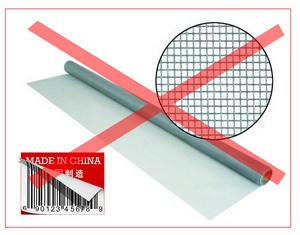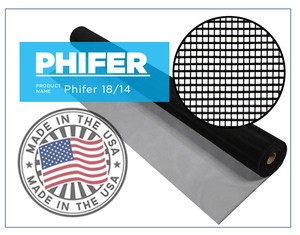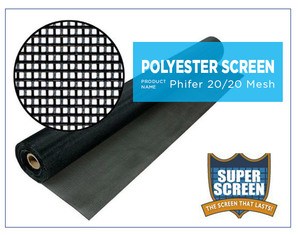People use screen enclosures for various reasons, but most customers don’t realize there are actually a few different types of screens. If you just want a screen to keep leaves out of your pool, then there’s a certain material for you. But if you want a screen that will keep even the tiniest bugs out and be able to withstand hurricane force winds, there’s a different type of material for you.
Let’s talk about the main types of materials used for screen enclosures, ranked from the least durable to the most durable, so you can decide which one fits your needs.

Artisan Wire
We mention Artisan Wire briefly just so you know it’s an option on the market, and many companies will try to sell you on it. However, it’s not an option with us since it is cheaply made and will only last you four years at the most. Many screen enclosure companies use Artisan Wire since it is cheap, but if it’s going to break down and have to be replaced in a few years anyway, why not spend a little extra so you can enjoy your enclosure a little longer?

Phifer
The Phifer 18/14 screen is our standard material we use for our screen enclosures. It’s made in Tuscaloosa, Alabama and will be in good shape for about 8 years or so. The 18/14 refers to the tiny rectangle openings making up the screen. So in this screen, there are 18 rectangle openings wide and 14 openings high in each square inch. There’s also a 20/20 mesh screen available, which obviously has tinier holes to keep even the smallest bugs out. Both types of screens are just as durable as one another, but the durability question is one that gets asked frequently.
Durability of Phifer Screens
When Phifer screens are brand new, they are durable enough to hold up in hurricane strength winds, in most situations. The problem with Phifer screens is they will lose their durability and toughness over time. In fact, it’s estimated that this type of screen loses nearly 75% of its strength within 3 years of it being installed.
The reasoning is because of the U/V rays constantly beaming down on the material and breaking it down. The sunlight can be intense in Florida, and the Phifer screens simply aren’t made to last forever. The screens can still be used effectively after 3 years, but you may experience more wear and tear. Once a Phifer screen reaches 7-8 years, virtually all of its durability is gone and it’s time to replace the screen entirely.

free guide
12 MODERN CURB APPEAL IDEAS
Polyester
Polyester screen enclosures are by far the most durable screens you can buy for both the short-term and long-term. People who plan on living in the same home for many years often choose polyester screens because there’s a chance the screen will outlast the time they spend at the home.
From a durability standpoint, polyester screens have a ball burst strength test rating of around 190lbs (compared to around 60lbs for the Phifer screens). This strength is obviously enough to withstand even the strongest hurricane winds we get in Florida.
Some lab tests indicate polyester screens could remain effective for more than 20 years. The secret is in the polyester yarn it’s made of, which is much stronger than the Phifer screens, has UV-tolerant characteristics and also includes a biocide to prevent algae and mildew growth. Not to mention the biocide also repels insects!
Which Screen Material is Best For You?
So to summarize, polyester screen enclosures are the most durable and will last the longest, but some people don’t find them to be necessary. Phifer screens usually provide everything a person needs at a lower price, but they just won’t last as long. Considering many people tend to only stay in their house for about 5 years or so, spending the additional money on a polyester screen isn’t justified sometimes.
People who want their screen enclosure for 5+ years would probably save money in the long run by investing in a polyester screen. The screen mesh has a 10-year warranty and the life expectancy is about twice as long.
Regardless of what you want to use your screen enclosure for, selecting the right material will make you more satisfied with your purchase. As you now know, not all screen enclosure materials are created equally, so we encourage you to put some serious thought into your options so you invest in the right fit.


Do the polyester screen enclosure eliminate the spider webs.
No, not at all.
Where does 20×20 super screen fall on the price and quality spectrum?
About the same as Superscreen 14/16, but not as durable.
I would like to put solid metal panels on the bottom screen area for both privacy and when gardening/weed eating near the pool enclosure. I haven’t been able to find anything other than kick plated which are too small for what I need. I need something taller than a 16″ kick plate, any recommendations?
36″ kick plate is available.
Thank you for talking about polyester screens and how they can be the more money-cautious choice for homeowners who need screens. There are a lot of things I wasn’t prepared for when I became a homeowner, and one of these things were random rodents and critters making their way into my house unnoticed. I wanted something that’s secure enough but can also last longer, so I’ll take your advice and look for any polyester screen doors that I can get installed for my house.
Doesn’t Phifer also have a vinyl coated polyester screen called Tuffscreen that is the same as superscreen in durability and will last just as long?
Yes that is correct. There is also ‘ultra-screen’ now as well.